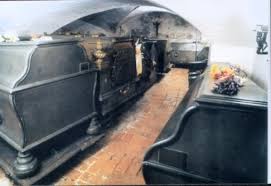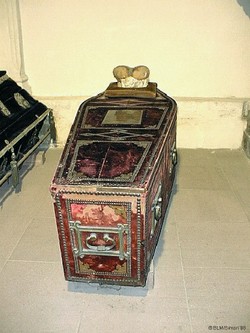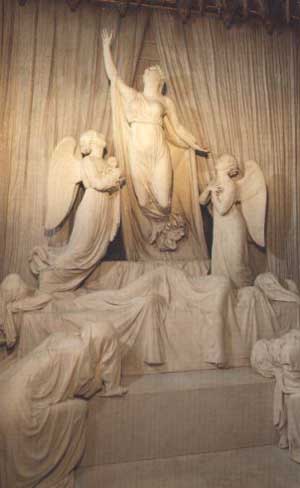by An Ard Rí and Susan Flantzer © Unofficial Royalty 2012
The House of Hanover ruled over the Kingdom of Great Britain and Ireland (and after 1801, the United Kingdom of Great Britain and Ireland) from 1714, following the death of Queen Anne, the last Stuart monarch, until the death of Queen Victoria in 1901.
Hanover Monarchs
- George I (reigned 1714-1727)
- George II (reigned 1727-1760)
- George III (reigned 1760-1820)
- George IV (reigned 1820-1830)
- William IV (reigned 1830-1837)
- Victoria (reigned 1837-1901)
- Unofficial Royalty: House of Hanover Index
- Unofficial Royalty: House of Hanover: Queen Victoria Index
Burial articles for all the British royal houses can be found at Unofficial Royalty: British Royal Burial Sites
An excellent resource: The Royal Tombs of Great Britain by Aidan Dodson, published in 2004
Unless otherwise noted, all pictures, portraits, and photos are from Wikipedia.
********************

Henry VII Chapel in Westminster Abbey – The Hanover Vault is under the central part of the chapel.
With a few exceptions, the early members of the House of Hanover were buried in the Hanover Vault under the central part of the Henry VII Chapel, and the later members of the House of Hanover were buried in the Royal Tomb House at St. George’s Chapel at Windsor Castle. Because the Hanover Vault at Westminster Abbey was running out of space, King George III had the Royal Tomb House constructed at St. George’s Chapel, Windsor Castle, under what is now the Albert Memorial Chapel.
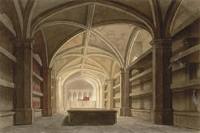
An artist’s view inside the Royal Vault at St. George’s Chapel. Caskets were placed on the shelves along the sides. The bench in the middle was used as a temporary place for caskets waiting to be buried elsewhere.
Above is a view inside the Royal Vault at St. George’s Chapel where many Hanovers were buried including George III and his wife, George IV, and William IV and his wife. Coffins were placed on the shelves along the sides. The bench in the middle was used as a temporary place for caskets waiting to be buried elsewhere. None of the Hanovers buried at St. George’s Chapel have a memorial except Princess Charlotte of Wales, who tragically died in childbirth at age 21 and most likely would have succeeded her father George IV to the throne.
For more information, see the websites below.
- Unofficial Royalty: Westminster Abbey in London, England
- Unofficial Royalty: Westminster Abbey: Royal Burials
- Unofficial Royalty: St. George’s Chapel in Windsor, England
- Unofficial Royalty: St. George’s Chapel, Windsor: Royal Burials
********************
George I, King of Great Britain (reigned 1 August 1714 – 11 June 1727)

Born His Highness Duke Georg Ludwig of Brunswick-Lüneburg, he became King George I of Great Britain, the first King of the House of Hanover, upon the death of Queen Anne, the last monarch of the House of Stuart in 1714. After the death of Queen Anne’s only surviving child, William, Duke of Gloucester, Parliament passed the 1701 Act of Settlement giving the throne to the Electress Sophia of Hanover – a granddaughter of James I, niece of Charles I, a cousin to Charles II and James II – and her Protestant descendants following the death of Queen Anne. Electress Sophia died eight weeks before Queen Anne died so her son George succeeded to the British throne.
Even though he was the King of Great Britain, George never lost sight that he remained Elector of Hanover. He lived mainly in Great Britain but did make several visits to Hanover and spent about 20% of his reign there. George remained Lutheran but was the head of the Church of England (Anglican Church) and the Church of Scotland (Presbyterian Church).
On June 3, 1827, King George I set out for another visit to Hanover. During the journey, George became ill and lost consciousness. It was noticed that his face had become distorted and his right hand hung limply at his side, a sign that he had suffered a stroke. The courtiers decided to continue with the journey to Hanover, where George died in the Prince-Bishop’s Palace at Osnabrück on June 11, 1827, at the age of 67. Following the instructions of George’s son, now King George II, George was buried in the chapel at Leineschloss. He was the first British monarch since King Richard I in 1199 to be buried outside of Britain. The castle and the chapel were severely damaged during World War II and in 1957, King George I’s remains were re-interred at the Berggarten Mausoleum at Schloss Herrenhausen in Hanover, Germany, near his mother’s burial site.
Sophia Dorothea of Celle, Electoral Princess of Hanover

Sophia Dorothea of Celle was the wife of George I and the mother of George II. George and Sophia Dorothea had an unhappy marriage and it led to both of them having affairs. Sophia Dorothea’s affair with Philip Christoph von Königsmarck led to von Königsmarck’s murder, George divorcing Sophia Dorothea (before he became King), and Sophia Dorothea being imprisoned in Castle of Ahlden for the last 33 years of her life. She never again saw her children (the future King George II and Sophia Dorothea, the future Queen Consort of Prussia) who are with her in the portrait above.
Sophia Dorothea apparently drowned her sorrows in the pleasure of eating, and became quite corpulent, increasingly suffering from fevers and indigestion. She suffered a stroke in August 1726 and never again left her bed. Sophia Dorothea refused medical attention and food and died on November 13, 1726, at the age of 60. King George I would not allow mourning at the British court and was furious when he learned that his daughter had ordered court mourning in Prussia.
Because the guards at the Castle of Ahlden had no funeral or burial instructions, Sophia Dorothea’s remains were placed in a lead coffin and stored in the castle cellar. In January 1727, orders came from London to bury the remains without any ceremony in the cemetery of Ahlden. However, this was impossible because of weeks of heavy rains and the coffin remained in the castle cellar. Finally, in May 1727, Sophia Dorothea was buried in the middle of the night beside her parents at the Stadtkirche St. Marien in Celle, Germany.
- Wikipedia: Stadtkirche St. Marien in Celle (in German)
********************
George II, King of Great Britain (reigned 11 June 1727 – 25 October 1760)
George II ascended the throne following the death of his father King George I. He married Caroline of Ansbach, the daughter of Johana Friedrich, Margrave of Brandenburg-Ansbach in August of 1705. The Jacobites once again unsuccessfully attempted to put a Catholic Stuart on the British throne in 1745-1746 during the Jacobite Rising of 1745. Also, the British National Anthem has its origins during King George II’s reign
On October 25, 1759, King George II woke up early at Kensington Palace and had his usual cup of chocolate. He asked about the direction of the wind as he was anxious about receiving his overseas mail, and then he entered his water closet. A few minutes later, his valet heard a crash and found George lying on the floor. He was put into bed and asked for his favorite daughter Princess Amelia, but he died before the princess reached him. An autopsy showed that he died of a ruptured aortic aneurysm.
King George II was buried at Westminster Abbey in a double black marble sarcophagus in the Hanover Vault under the central part of the Henry VII Chapel. George II has no monument and only an inscription on the floor marks the site of his burial place. After George was placed next to his wife in the double sarcophagus, the sides of the two coffins were removed so they could be near each other in death. He was the last monarch to be buried at Westminster Abbey.
Because George II’s eldest son Frederick, Prince of Wales predeceased him, he was succeeded by his grandson King George III, Frederick’s eldest son.
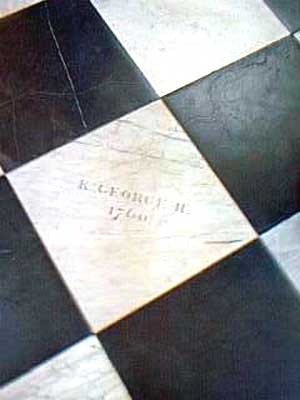
Inscription on the floor of the Henry VII Chapel at Westminster Abbey marking the grave of George II. photo: www.findagrave.com
Caroline of Ansbach, Queen of Great Britain

Caroline was the wife of George II and the grandmother of George III. Queen Caroline played a greater role in governmental affairs than any queen consort since the Middle Ages. During the absences of her husband, Caroline led the affairs of state, together with Prime Minister Robert Walpole. Caroline had many scientific and artistic interests. She corresponded with several intellectuals including mathematician Gottfried Leibniz, supported French philosopher Voltaire during his exile in England from 1726-1729, and one of the greatest promoters of the composer George Frideric Handel, who had come to England with King George I.
In 1724, during the birth of her youngest child, Caroline sustained an umbilical hernia. She ignored the condition until it became acute in November of 1737. Then she was bled, purged, and operated on, without anesthetic, but there was no improvement in her condition. Gangrene set in and she died on November 20, 1737, at St. James’ Palace in London at the age of 54. As she lay dying, she begged her grief-stricken husband to marry again. George replied, “Never, never. I shall have only mistresses.” When George died, he left instructions that the side boards of their coffins be removed so the two could be joined together in death.
Caroline was buried with her husband at buried at Westminster Abbey in a double black marble sarcophagus in the Hanover Vault under the central part of the Henry VII Chapel. An inscription on the floor marks the site of her burial place. She was the last consort to be buried at Westminster Abbey. George Frideric Handel, who had been her friend for more than 30 years, composed, within a week, The Ways of Zion Do Mourn / Funeral Anthem for Queen Caroline, which was performed at her funeral on December 17, 1737.
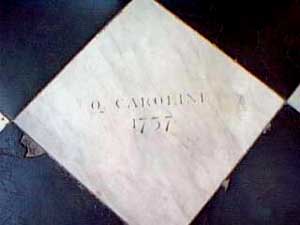
Inscription on the floor of the Henry VII Chapel at Westminster Abbey marking the grave of Caroline of Ansbach. photo: www.findagrave.com
********************
Frederick, Prince of Wales

Frederick was the eldest son of George II and Caroline of Ansbach and the father of George III. He was created Prince of Wales in 1729 and married Princess Augusta of Saxe-Gotha-Altenburg in April 1736. Frederick made a point of opposing his parents in nearly everything. He annoyed them when he and Augusta appeared in public together because the couple was popular with the public. When Augusta went into labor with her first child at Hampton Court Palace where the King and Queen were in residence, Frederick insisted that Augusta endure a bumpy carriage ride back to St. James’ Palace in London just to prevent his hated parents from being present at the birth. This event created an even larger rift between Frederick and his parents.
Frederick became ill in March 1751 after he caught “a chill” while gardening at his home Kew Palace. He became feverish and was bled and blistered, the medical treatment of the time. After a brief recovery, Frederick suffered a relapse and was again bled. After eating a light supper on the evening of March 21, 1751, at Leicester House in London, Frederick suffered a coughing fit and died suddenly at the age of 44. An autopsy found the cause of death to be a burst abscess in the lung. It was popularly believed that his death was caused by a blow from a cricket ball in his chest but there is no proof of that. Frederick was buried at Westminster Abbey in the Hanover vault under the central part of the Henry VII Chapel.
Augusta of Saxe-Gotha-Altenburg, Princess of Wales

Augusta, daughter of Friedrich II, Duke of Saxe-Gotha-Altenburg was the wife of Frederick, Prince of Wales. Frederick and Augusta had nine children including King George III who succeeded his grandfather King George II and Caroline Matilda, Queen Consort of Denmark.
At the time of Frederick’s death, his 32-year-old widow was pregnant with her ninth child. Augusta spent her years as a widow raising her nine children and improving the gardens at Kew Palace, which today are a world-class botanical garden. Augusta died of cancer of the throat in 1772 at the age of 52 and was buried at Westminster Abbey in the Hanover Vault under the central part of the Henry VII Chapel.
********************
George III, King of the United Kingdom (reigned 25 October 1760 – 29 January 1820)

George III was the son of Frederick, Prince of Wales, and Augusta of Saxe-Gotha-Altenburg. He became King upon the death of his grandfather, George II, in 1760. In 1761, George married Charlotte of Mecklenburg-Strelitz and the couple had 15 children including King George IV, King William IV, and Prince Edward, Duke of Kent, the father of Queen Victoria. George is noted for his periods of illness and mental instability possibly caused by the hereditary disease porphyria. However, George established himself as one of the more popular Hanoverian kings. He was admired for his respectable private life and gained sympathy for his illness.
Eventually, George became so ill that it was necessary for Parliament to pass the Regency Act of 1811. The Prince of Wales (the future King George IV) acted as Regent until his father died in 1820. Queen Charlotte was her husband’s legal guardian but could not bring herself to visit him due to his violent outbursts and erratic behavior.
George spent the rest of his life at Windsor Castle, blind, deaf, and in a state of dementia. He was unaware that Charlotte died in November of 1818. At Christmas of 1819, George spoke nonsense for 58 hours, and for the last few weeks of his life was unable to walk. Under the care of his second son Frederick, Duke of York, King George III lived on until January 29, 1820, six days after the death of his fourth son, Edward, Duke of Kent. His remains were buried at St. George’s Chapel, Windsor Castle in the Royal Tomb House that he had constructed under St. George’s Chapel, Windsor, which is now under the Albert Memorial Chapel.
Charlotte of Mecklenburg-Strelitz, Queen of the United Kingdom

Charlotte, daughter of Duke Karl Ludwig Friedrich of Mecklenburg-Strelitz, Prince of Mirow and his wife, Princess Elizabeth Albertine of Saxe-Hildburghausen, married George III in 1761. She gave birth to fifteen children, all of whom survived childbirth. Only two of the children did not survive childhood. Charlotte played no part in politics and was content in dealing with family affairs. The only disruption in the family’s domestic lives was George’s attacks of illness. We now know that King George probably suffered from porphyria and his attacks severely worried Charlotte.
Queen Charlotte died on November 17, 1818, at Kew Palace seated in a small armchair holding the hand of her eldest son. She was buried at St. George’s Chapel at Windsor Castle in the Royal Vault George III had constructed which is now under the Albert Memorial Chapel. Charlotte is the second longest-serving consort in British history. Only her descendant, Prince Philip, Duke of Edinburgh, husband of Queen Elizabeth II, has served longer.
********************
George IV, King of the United Kingdom (reigned 29 January 1820 – 26 June 1830

George IV was the eldest son of George III and Charlotte of Mecklenburg-Strelitz. His marriage to Caroline of Brunswick, his first cousin, was a disaster. It is doubtful that the couple spent more than a few nights together as husband and wife. Their only child, Princess Charlotte of Wales, was born nine months later. They both found each other equally unattractive and never lived together nor appeared in public together.
From 1811 until 1820, he served as Prince Regent during his father’s incapacitation. and became king upon his father’s death in 1820. George IV’s final illness began in January 1830 with a severe cough. He improved slightly in March 1830 but continued to have respiratory problems, faintness, and urinary tract pain. King George IV died at the age of 67 on June 26, 1830, at Windsor Castle and the throne passed to the next surviving son of King George III, Prince William, Duke of Clarence who reigned as King William IV. George IV was buried at St. George’s Chapel, Windsor in the Royal Vault George III had constructed which is now under the Albert Memorial Chapel.
Caroline of Brunswick, Queen of the United Kingdom

Caroline of Brunswick-Wolfenbüttel, daughter of Karl II, Duke of Brunswick-Wolfenbüttel and Princess Augusta of Wales, eldest sister of George III, married her first cousin, the future George IV, in April 1795. The marriage was an unhappy one. George later tried to divorce Caroline and barred her from his Coronation Service.
Three weeks after the coronation, on August 7, 1821, Caroline died at the age of 53, most likely from a bowel obstruction or cancer. Prior to her death, Caroline had requested that she be buried in her native Brunswick. The official route of Caroline’s cortege through London was to avoid major streets. However, members of the public blocked those streets and forced a new route through the major streets. Caroline was buried at Brunswick Cathedral, now in Germany, alongside her father. Her casket bears the inscription, “Here lies Caroline, the Injured Queen of England.”
Princess Charlotte of Wales

- Unofficial Royalty: Princess Charlotte of Wales
- Death of Princess Charlotte of Wales in childbirth and its impact on the British succession
The only child of George IV and Caroline of Brunswick-Wolfenbüttel, Princess Charlotte married Prince Leopold of Saxe-Coburg-Saalfeld (the future King Leopold I of the Belgians), uncle of Queen Victoria and Prince Albert, in May of 1816. Princess Charlotte died at age 21 on November 6, 1817, of childbirth complications following a fifty-hour labor. The child, who was a boy, was stillborn. The princess was buried at St. George’s Chapel, Windsor in the Royal Vault George III had constructed which is now under the Albert Memorial Chapel, with her stillborn son at her feet. The country was wild with grief as Charlotte was second in line to the throne and was expected to be Queen after her grandfather George III and her father, the future George IV. Three months after Charlotte’s death, her doctor, Sir Richard Croft, died by suicide by shooting himself while attending another birth.
********************
Prince Edward, Duke of Kent and Strathearn

Edward was the fourth son of King George III and Charlotte of Mecklenburg-Strelitz and the father of Queen Victoria. He married Princess Victoria of Saxe-Coburg-Saalfeld, the daughter of Franz Frederick Anton, Duke of Saxe-Coburg-Saalfeld, on July 11, 1818. Their only child, the future Queen Victoria, was born on May 24, 1819.
Toward the end of 1819, Edward leased Woolbrook Cottage in Sidmouth, a town on the English Channel, due to the need to economize and the benefits the sea air would have for the Duchess’ health. In early January, Edward caught a cold but insisted on taking a walk out in the chilly weather. Within days, the cold worsened, and he became feverish and delirious and developed pneumonia. His condition was aggravated by the bleeding and cupping of the physician sent from London to treat him. Edward became increasingly weaker and died on January 23, 1820, just six days before his father, King George III died. The Duke of Kent was buried at St George’s Chapel, Windsor in the Royal Vault George III had constructed which is now under the Albert Memorial Chapel. His daughter was only eight months old.
Victoria of Saxe-Coburg-Saalfeld, Duchess of Kent

Unofficial Royalty: Victoria of Saxe-Coburg-Saalfeld
Princess Victoria was the wife of Edward, Duke of Kent and the mother of Queen Victoria. The Duchess of Kent was left a widow with an eight-month-old child upon the death of her husband. During the future Queen Victoria’s childhood at Kensington Palace, the Duchess along with her household comptroller Sir John Conroy tried to control and influence Victoria with their Kensington System, a strict and elaborate set of rules. The Duchess’ relationship with her daughter Victoria suffered greatly and did not normalize until Victoria herself had children.
In March 1861, after the Duchess had surgery on her arm to remove an ulcer, a severe infection developed. At 9:30 on the morning of March 16, 1861, the Duchess of Kent died at the age of 74 without regaining consciousness. The Duchess of Kent was temporarily buried in the entrance to the Royal Vault in St. George’s Chapel and was transferred to her mausoleum at Frogmore within the grounds of the Home Park, adjacent to Windsor Castle on August 1, 1861.
- Unofficial Royalty: Royal Burial Ground and Mausoleums at Frogmore: Royal Burials
- Wikipedia: Frogmore – The Duchess of Kent’s Mausoleum

Mausoleum of the Duchess of Kent
********************
William IV, King of the United Kingdom of Great Britain and Ireland (reigned 26 June 1830 – 20 June 1837)

William was the third son of George III and brother/successor to George IV. He married Princess Adelaide of Saxe-Meiningen, the daughter of Georg I, Duke of Saxe-Meiningen in July 1818. Despite having ten illegitimate children (before his marriage) with his long-time mistress Dorothea Jordan, William did not have any surviving legitimate children. William’s heiress presumptive was his niece Princess Victoria of Kent, the only child of his brother Prince Edward, Duke of Kent.
King William IV had become ill with asthma or hay fever in May of 1837, and pneumonia soon developed. He died peacefully at 2:15 AM on June 20, 1837, at Windsor Castle and Princess Victoria ascended to the throne. An autopsy showed that heart disease and cirrhosis of the liver had contributed to his death. William was buried in the Royal Tomb House at St. George’s Chapel, Windsor in the Royal Vault George III had constructed which is now under the Albert Memorial Chapel.
Adelaide of Saxe-Meiningen, Queen of the United Kingdom

Queen Adelaide was the wife of King William IV. She gave birth to two daughters, both of whom died in infancy and then had stillborn twin boys. Adelaide wrote to her widowed sister-in-law the Duchess of Kent, “My children are dead, but your child lives, and she is mine too.” That child was the future Queen Victoria. Adelaide had close and loving relationships with her stepchildren and step-grandchildren, with her brother and sister’s children, and with William’s nieces and nephews, the future Queen Victoria and the Cambridge children.
Queen Adelaide died on December 2, 1849, at Bentley Priory in Middlesex and the age of 57. She survived William by 12 years, dying on December 2, 1849, at the age of 57. After a simple funeral in accordance with her wishes, Queen Adelaide was buried at St. George’s Chapel, Windsor in the Royal Vault George III had constructed which is now under the Albert Memorial Chapel.
********************
Victoria, Queen of the United Kingdom (reigned 20 June 1837 – 22 January 1901)

Queen Victoria was the daughter of Edward, Duke of Kent and Victoria of Saxe-Coburg-Saalfeld. On June 20, 1837, she became Queen following the death of her uncle, King William IV. In 1840, Victoria married her first cousin Prince Albert of Saxe-Coburg and Gotha and the couple had nine children. Victoria and Albert’s children and grandchildren married into other European royal families giving Victoria the unofficial title of “Grandmother of Europe.” Victoria and Albert’s descendants currently sit upon the thrones of Denmark, Norway, Spain, Sweden, and the United Kingdom. Prince Albert died in 1861, leaving Queen Victoria a widow for forty years.
On December 18, 1900, she traveled to her beloved Osborne House on the Isle of Wight for the last time. The journey exhausted her, but after a few days, she seemed somewhat recovered. However, by January 16, 1901, it was obvious that Queen Victoria’s life was drawing to an end. She died on January 22, 1901, surrounded by her family. Her funeral was held at St. George’s Chapel at Windsor Castle, and she was interred beside Prince Albert in the Royal Mausoleum at Frogmore in Windsor Great Park adjacent to Windsor Castle.

Queen Victoria and Prince Albert’s Mausoleum and the Royal Burial Ground
Albert of Saxe-Coburg and Gotha, Prince Consort of the United Kingdom
Prince Albert of Saxe-Coburg and Gotha, son of Ernst I, Duke of Saxe-Coburg and Gotha, and his first wife, Louise of Saxe-Gotha-Altenburg, was the husband and first cousin of Queen Victoria. They married on February 10, 1840, and had nine children. Many of Europe’s current royalty are their descendants.
Prince Albert died on December 14, 1861, at Windsor Castle. Sir William Jenner, one of Prince Albert’s doctors, diagnosed his final illness as typhoid fever but Albert’s modern biographers have argued that the diagnosis is incorrect. Albert had been complaining of stomach pains for two years and this may indicate that he died of some chronic disease, perhaps Crohn’s disease, kidney failure, or cancer.
On December 23, 1861, Albert’s coffin was placed in the entrance to the Royal Vault. Upon completion of the Royal Mausoleum at Frogmore within the grounds of the Home Park, adjacent to Windsor Castle, Albert’s coffin was transferred there on December 18, 1862.
- Unofficial Royalty: Royal Burial Ground and Mausoleums at Frogmore: Royal Burials
- Wikipedia: Frogmore – Royal Mausoleum
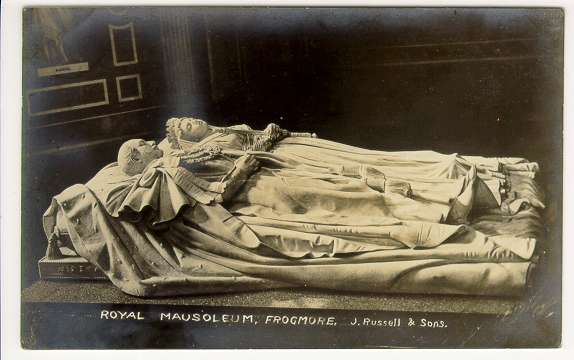
The sarcophagus of Queen Victoria and Prince Albert at the Royal Mausoleum at Frogmore. photo: www.findagrave.com
********************
This article is the intellectual property of Unofficial Royalty and is NOT TO BE COPIED, EDITED, OR POSTED IN ANY FORM ON ANOTHER WEBSITE under any circumstances. It is permissible to use a link that directs to Unofficial Royalty.


